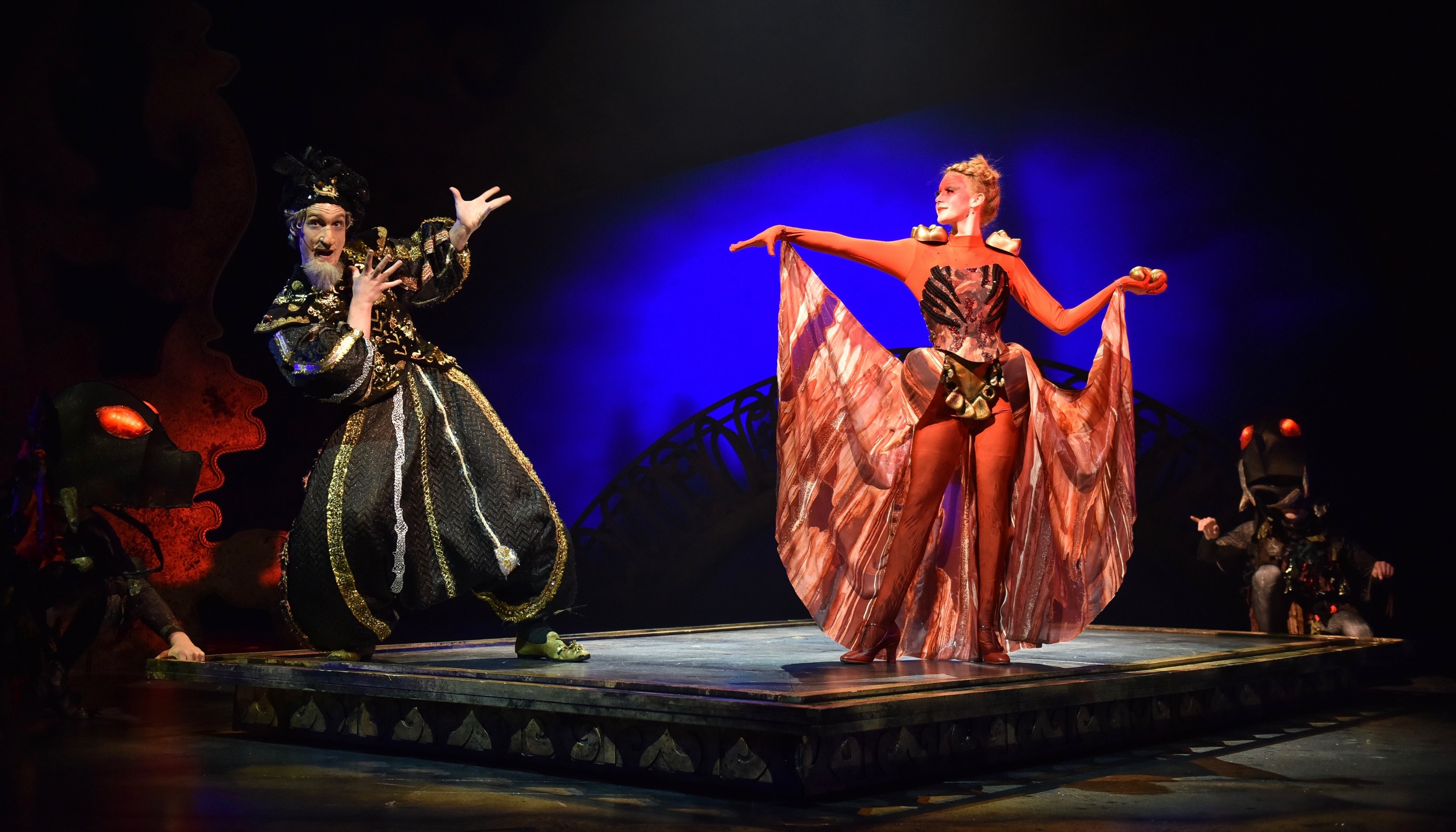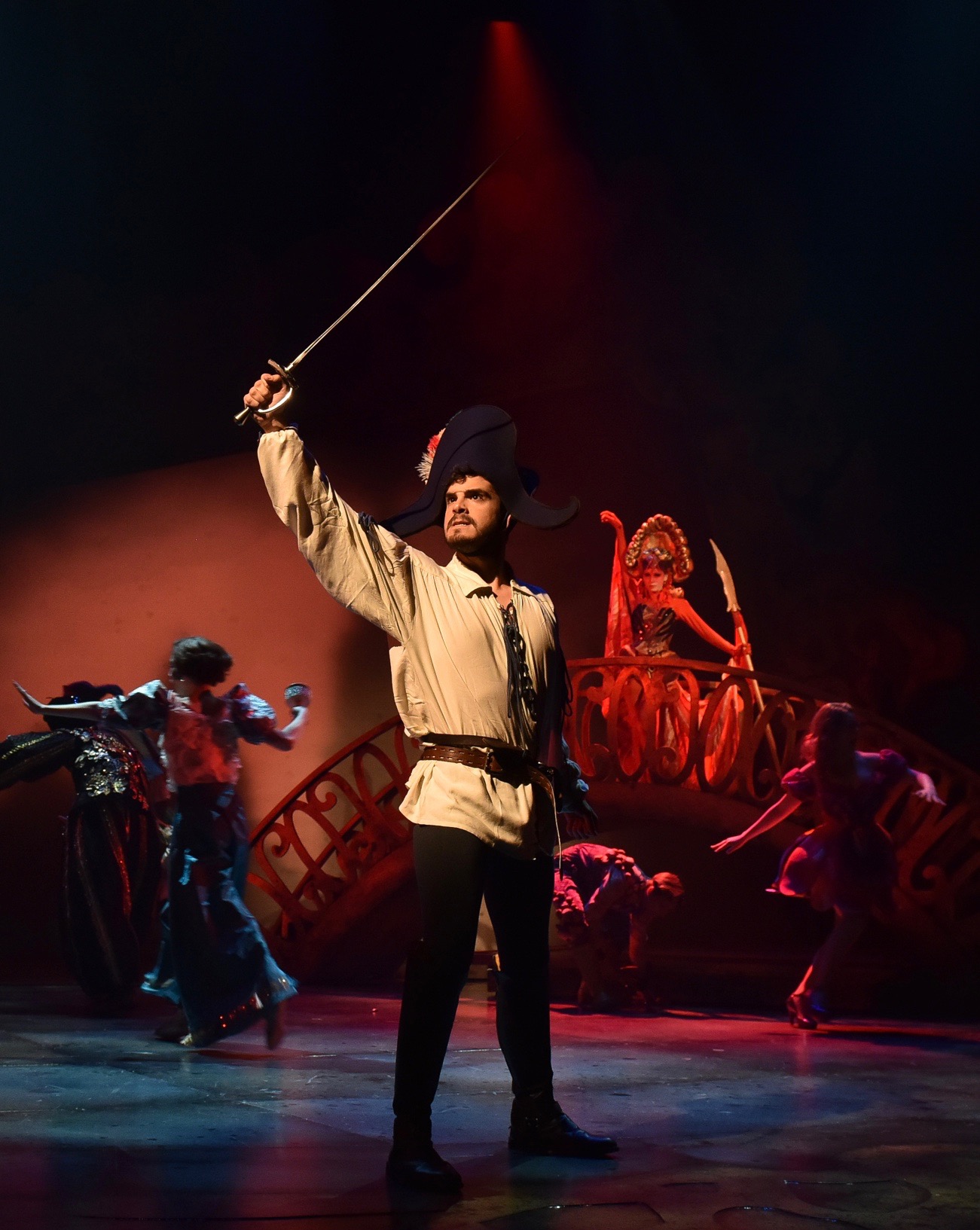CMU’s ‘The Plague in Venice’ Wakes Weird Echoes—Then Amplifies Them

Is this a pestilence which I see before me? It is, it is, as the Doge of Venice (Patrick Hart) cowers comically under the not-so-discreet charms of Plague (Caroline Pluta).
Once upon a time the big choice for theater-goers was whether to see a comedy or a tragedy. That line is now blurred as we have entered an Age of Irony, when even the darkest plays are laced with humor and comedies often turn seriocomic. Today the big question in choosing a play is whether you want to go real or go weird.
Realistic plays are those in which characters who are mortal humans engage in activities that may be extreme but don’t violate the laws of nature. Weird plays have supernatural elements and reality-bending stage effects. They tend to differ in tone and attitude from Marvel movies or world-of-wizard sagas, though they’re also a long way from Kansas.
If that kind of weirdness fits your taste, The Plague in Venice fits the profile. Currently being staged by Carnegie Mellon’s School of Drama, this play has characters whose names are Plague and Death. It features wacky physical comedy and bizarre music, but it’s not a musical nor a laugh-a-minute comedy.
Devised by CMU drama students under guest director Sasha Iliev—a Bulgarian theater artist and anthropologist who, in one of his less scholarly adventures, made the Guinness Book of World Records by performing 24 consecutive hours of mime—the play includes actors dressed as giant rats with glowing electric-red eyes, along with a monstrous puppet and other striking stunts.
Am I conveying the extent of the weirdness? Good. For a firmer grasp of where The Plague in Venice came from, let’s wind back to its origin.
The Real Plague, the Original Author
During the 1570s, the bubonic plague struck the Republic of Venice, killing about a quarter of the population. Some years later, actor and writer Flaminio Scala (1552-1624) created a stage play based on the event.
Scala was a leading practitioner of commedia dell’arte, the red-hot genre that originated in Italy and spread, like the plague, to other parts of Europe. Commedia is a highly stylized form of racy, buffoonish satire built around such stock characters as il Dottore (the Doctor, a learned ass), il Capitano (a swaggering yet cowardly Captain), and the servant Arlecchino, a trickster whose name lives on in the English language as Harlequin. Scandalous for the times, the female characters were played by women, helping set the precedent in Western theater.
Commedia dell’arte also emerged as a highly improvised form. The actors worked from sketchy plot “scenarios” that allowed plenty of room for collective tinkering. Here are two scenario fragments, not from The Plague in Venice, illustrating the nature of both the scripting and the comedy:
“Franceschina steps out; Arlecchino immediately drops the bag in order to fondle her. The Captain starts to beat Arlecchino …”
“… Pedrolino arrives, saying that the court doesn’t concern itself with cuckolds and whores, and that he needs to deal with the case on his own. He sees Franceschina and tries to kill her. Everyone stands between them …”
Audiences ranging from rustics to royalty loved the stuff. Works of commedia and plays inspired by it are still performed, although theater troupes often substantially modify them. Earlier this season, Pittsburgh Public Theater mounted a somewhat toned-down version of Carlo Goldoni’s (1707-1793) Servant to Two Masters. By contrast, Iliev and his Carnegie Mellon students have pulled out all the stops in adapting Scala’s The Plague in Venice.
Venomous Kisses and the Teeth of Death
One may wonder why something as terrible as the plague was treated comically. Scala used the tragic subject to mock the foibles and greediness of the elite. When the Plague (personified in this production by Caroline Pluta) makes her dramatic entrance, she delivers a speech that goes roughly as follows:
“My beauty is intoxicating. My kiss, venomous. My life, lethal … But in the infection lies the cure. For this beautiful city has already been sickened, diseased, from the inside, by the Doge, whose gross corruption seeps poison into his people … [The city] must be infected to be cured …”
I say it goes “roughly” like this because the Carnegie Mellon team, in the commedia tradition, may improvise from one performance to the next. Other aspects of the play are not so tradition-bound. For example, the actors don’t always hew strictly to the cartoonish, Ministry-of-Silly-Walks movements that marked the stock characters in classic commedia. One actor who gives it the full Monty Python is Sam McInerney, playing the greedy merchant Pantalone, and he’s a treat to watch.

While Venice buckles, Cappocomico (Ryan Avalos) boldly swashbuckles.
CMU’s The Plague in Venice is also a more lavish production than those typically mounted by the traveling commedia troupes of olden times. You’ve got the electric rats, an enormous full moon floating spectacularly above the stage, and Death’s huge and ghastly costume—actually a larger-than-life skeletal puppet that actor Clay Singer wears on his shoulders and manipulates convincingly. (It should be noted, however, that Death’s spookiest feature is a natural one: Singer’s teeth. He’s got a stupendous array of gleaming white choppers. They show beneath his dark mask, and he brandishes them in hungry leers that are more electrifying than the rats’ eyes.)
The Existential Howl
As for the story, much of it is mass mania. Death, Plague, and Plague’s army of rats swoop amid terrified citizens who nonetheless persist in groping for sex and grasping for power. Several scenes are full of raucous shrieks accompanied by wailing, thumping music.
Sitting there, I thought: This is quite a spectacle, though it doesn’t seem exactly like true commedia but rather a creation of its own kind. It vaguely reminded me of another work of art: The Fugs’ 1965 song “The Swinburne Stomp,” in which poet Ed Sanders, backed by splendid cacophony, chants a passage from “Atalanta in Calydon” by the famously weird 19th-century writer Algernon Charles Swinburne. Perhaps you could call this play The Scala Stomp. Like the song, it’s a mocking riff on the ultimately frightening human predicament, so if you’re in the mood for something utterly out of history’s left field, try The Plague.
Ticket Info
The Plague in Venice, directed by Sasha Iliev, runs through April 23 in the Philip Chosky Theater at Purnell Center for the Arts on Carnegie Mellon’s campus, 5000 Forbes Ave., Oakland. For showtimes and tickets visit the School of Drama website or call 412-268-2407.
Photos by Louis Stein.
Mike Vargo, a Pittsburgh-based writer and editor, covers theater for Entertainment Central.
Share on Social Media
Follow Entertainment Central
Latest Stories
Sign up for the EC Newsletter







